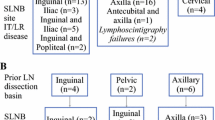Abstarct
Background
Sentinel lymph node biopsy (SLNB) is the most precise method for staging invasive cutaneous melanoma, but its therapeutic effect has been difficult to assess, and SLNB is not routinely used in all melanoma treatment centers.
Methods
This case-control study of 305 prospective SLNB patients compared them with 616 retrospective patients who had not undergone invasive nodal staging at diagnosis. Thin melanomas were included in both study groups.
Results
A total of 50 SLNB patients were sentinel positive (16.4%) and 255 were sentinel negative (83.6%). A total of 49 of the 50 sentinel-positive patients underwent completion lymph node dissection, and 9 of them (18%) had additional metastases in the nonsentinel nodes. The false-negative rate was 1.6% (five same-basin nodal recurrences during follow-up). There was a significant difference in melanoma-related overall survival (OS) between sentinel-positive and sentinel-negative patients (P < .001). The tumor burden of the sentinel nodes was a significant prognostic factor for melanoma-related OS (P < .001). There was no significant difference in melanoma-related OS or disease-free survival between the study groups, but the nodal disease-free survival was significantly longer among the SLNB patients (P = .004).
Conclusions
SLNB is recommended for routine use in the treatment of cutaneous melanoma because the sentinel node status carries unique prognostic information on the survival of melanoma patient. Improved regional disease control is an obvious therapeutic advantage of SLNB and immediate completion lymph node dissection.






Similar content being viewed by others
References
Morton DL, Wen DR, Wong JH, et al. Technical details of intraoperative lymphatic mapping for early stage melanoma. Arch Surg 1992;127:392–9
Gershenwald JE, Thompson W, Mansfield, et al. Multi-institutional melanoma lymphatic mapping experience: the prognostic value of sentinel lymph node status in 612 stage I or II melanoma patients. J Clin Oncol 1999;17:976–83
Cascinelli N, Belli F, Santinami M, et al. Sentinel lymph node biopsy in cutaneous melanoma: the WHO Melanoma Program experience. Ann Surg Oncol 2000;7:469–74
Essner R. Experimental frontiers for clinical applications: novel approaches to understanding mechanisms of lymph node metastases in melanoma. Cancer Metastasis Rev 2006;25:257–67
Leong SP, Cady B, Jablons DM, et al. Clinical patterns of metastasis. Cancer Metastasis Rev 2006;25:221–32
Balch CM, Buzaid AC, Soong SJ, et al. Final version of the American Joint Committee on Cancer staging system for cutaneous melanoma. J Clin Oncol 2001;19:3635–48
Starz H, Balda BR, Kramer KU, Buchels H, Wang HA. micromorphometry-based concept for routine classification of sentinel lymph node metastases and its clinical relevance for patients with melanoma. Cancer 2001;91:2110–21
Dewar DJ, Newell B, Green MA, Topping AP, Powell BW, Cook MG. The microanatomic location of metastatic melanoma in sentinel lymph nodes predicts nonsentinel lymph node involvement. J Clin Oncol 2004;22:3345–9
Thomas JM. Caution with sentinel node biopsy in cutaneous melanoma. Br J Surg 2006;93:129–30
Morton DL, Thompson JF, Cochran AJ, et al. Sentinel-node biopsy or nodal observation in melanoma. N Engl J Med 2006;355:1307–17
Gutzmer R, Al Ghazal M, Geerlings H, Kapp A. Sentinel node biopsy in melanoma delays recurrence but does not change melanoma-related survival: a retrospective analysis of 673 patients. Br J Dermatol 2005;153:1137–41
Kettlewell S, Moyes C, Bray C, et al. Value of sentinel node status as a prognostic factor in melanoma: prospective observational study. BMJ 2006;332:1423–7
Starz H, Siedlecki K, Balda BR. Sentinel lymphonodectomy and S-classification: a successful strategy for better prediction and improvement of outcome of melanoma. Ann Surg Oncol 2004;11:162S–8S
Kretschmer L, Hilgers R, Mohrle M, et al. Patients with lymphatic metastasis of cutaneous malignant melanoma benefit from sentinel lymphonodectomy and early excision of their nodal disease. Eur J Cancer 2004;40:212–8
Agnese DM, Abdessalam SF, Burak WE Jr, Magro CM, Pozderac RV, Walker MJ. Cost-effectiveness of sentinel lymph node biopsy in thin melanomas. Surgery 2003;134:542–7
Stitzenberg KB, Groben PA, Stern SL, Thomas NE, Hensing TA, Sansbury LB, Ollila DW. Indications for lymphatic mapping and sentinel lymphadenectomy in patients with thin melanoma (Breslow thickness ≤1.0 mm). Ann Surg Oncol 2004;11:900–6
Koskivuo I, Suominen E, Niinikoski J, Talve L. Sentinel node metastasectomy in thin ≤1-mm melanoma. Langenbecks Arch Surg 2005;390:403–7
McMasters KM, Wong SL, Edwards MJ, et al. Frequency of nonsentinel lymph node metastasis in melanoma. Ann Surg Oncol 2002;9:137–41
Roka F, Mastan P, Binder M, et al. Prediction of non–sentinel node status and outcome in sentinel node–positive melanoma patients. Eur J Surg Oncol doi:10.1016/j.ejso.2007.01.027
Cochran AJ, Wen DR, Huang RR, Wang HJ, Elashoff R, Morton DL. Prediction of metastatic melanoma in nonsentinel nodes and clinical outcome based on the primary melanoma and the sentinel node. Mod Pathol 2004;17:747–55
Carlson GW, Murray DR, Lyles RH, Staley CA, Hestley A, Cohen C. The amount of metastatic melanoma in a sentinel lymph node: does it have prognostic significance? Ann Surg Oncol 2003;10:575–81
Satzger I, Völker B, Al Ghazal M, Meier A, Kapp A, Gutzmer R. Prognostic significance of histopathological parameters in sentinel nodes of melanoma patients. Histopathology 2007;50:764–72
Author information
Authors and Affiliations
Corresponding author
Rights and permissions
About this article
Cite this article
Koskivuo, I., Talve, L., Vihinen, P. et al. Sentinel Lymph Node Biopsy in Cutaneous Melanoma: A Case-Control Study. Ann Surg Oncol 14, 3566–3574 (2007). https://doi.org/10.1245/s10434-007-9606-2
Received:
Revised:
Accepted:
Published:
Issue Date:
DOI: https://doi.org/10.1245/s10434-007-9606-2




